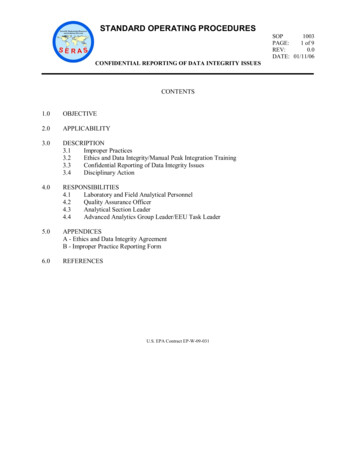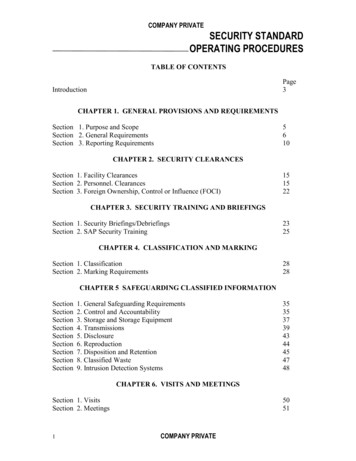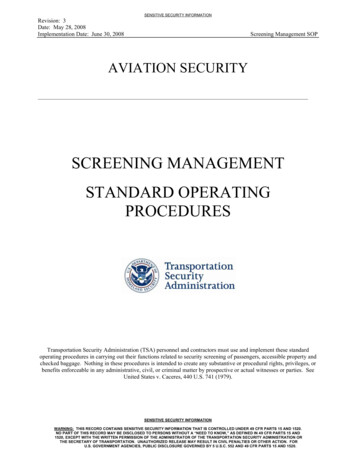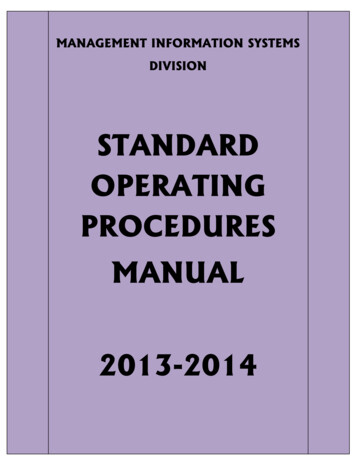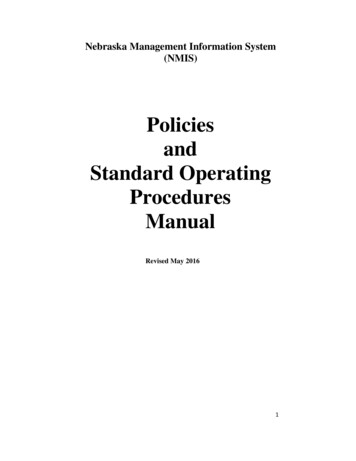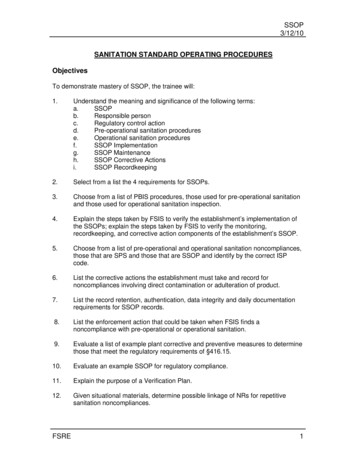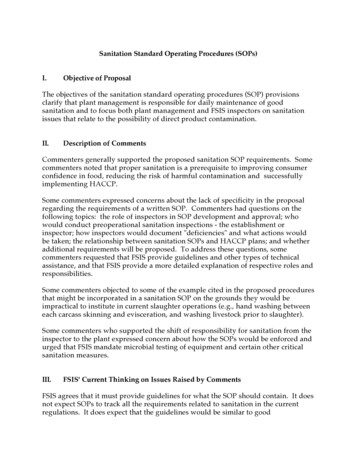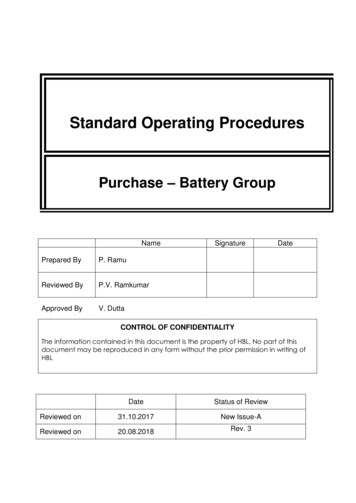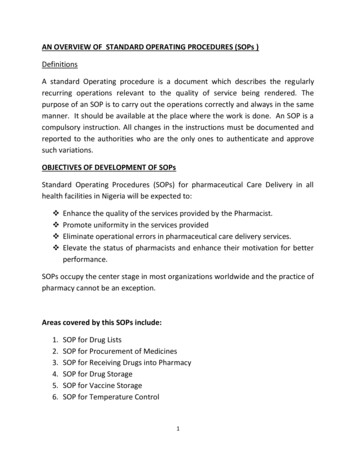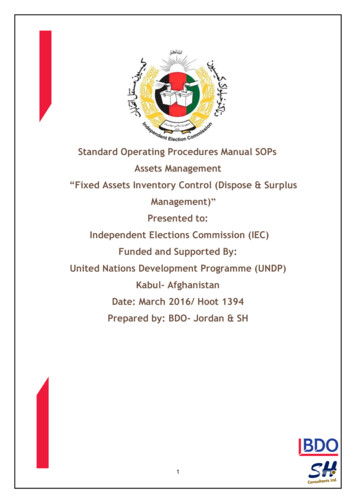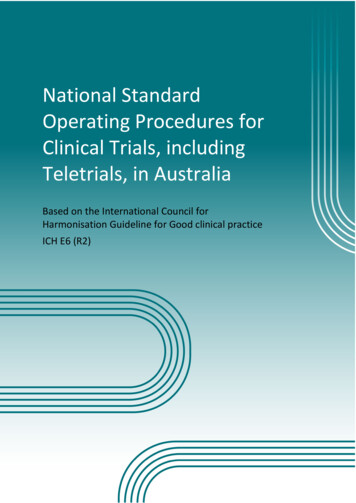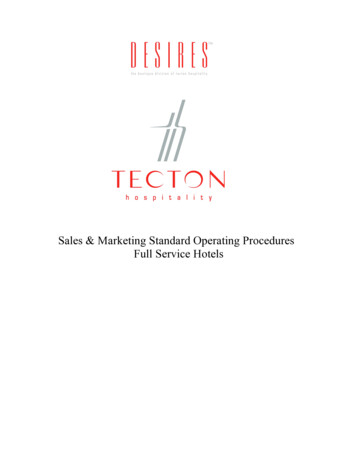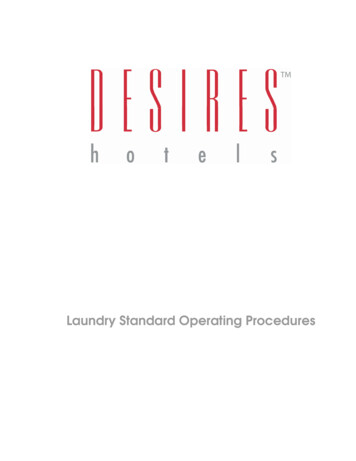
Transcription
Laundry Standard Operating Procedures
TABLE OF CONTENTSLDY-SOP-01: GOALS OF LAUNDERING . 3SCOPE: . 3PROCEDURE:. 3LDY-SOP-02: HOUSEKEEPING. 9SCOPE: . 9PROCEDURE:. 9LDY-SOP-03: LAUNDRY FIRE SAFETY . 10SCOPE: . 10PROCEDURE:. 10LDY-SOP-04: SORTING/CLASSIFYING/WEIGHING OF LINEN . 11SCOPE: . 11PROCEDURE:. 11LDY-SOP-05: FLATWORK PRODUCTION/WAXING PROCEDURES/TROUBLESHOOTING GUIDE. 13SCOPE: . 13PROCEDURE:. 13LDY-SOP-06: RECLAMATION OF LINEN . 16SCOPE: . 16PROCEDURE:. 16LDY-SOP-07: CONTROL OF UTILITIES. 18SCOPE: . 18PROCEDURE:. 18LDY-SOP-08: PRODUCTION RECORDING PROCEDURES. 19SCOPE: . 19PROCEDURE:. 19LDY-SOP-09: LAUNDRY ALLOCATION- POINT SYSTEM . 22SCOPE: . 22PROCEDURE:. 22ATTACHMENTS INCLUDED IN LAUNDRY-SOP . 25
GOALS OF LAUNDERINGM.O.V.E.S.Managing OperatingVisions Ensuring SuccessVISION: Each property will achieve the best quality possible, themost efficient and economical way. Strict adherence to properwash formulas as they relate to types of soils and fabrics must begiven.TEAM PLAYERS: LAUNDRYMOVE #:LDY-SOP-01EFFECTIVE DATE:DATE REVISED:3/1/973/1/97SCOPE:With continual new and changing fabrics and laundry chemicals in the marketplace, the laundry operation must keep abreast of the changes in order toachieve and maintain high quality standards.PROCEDURE:GOALS OF LAUNDERING1.EFFICIENCYIn order to gain efficiency in the washing process, it is imperative that linen isproperly classified in specific categories prior to washing. Additionally, thewash wheels must be properly loaded and wash formulas followed.Adherence to these three basic requirements will result in obtaining theefficiency in the washing process.2.ECONOMICAL OPERATIONEconomical operation of the laundry can be maintained through proper useof time and materials. The four most critical issues to achieve this objectiveare:3. Use of prescribed quantities of chemicals. Use of proper water levels. Maintenance of equipment. Proper scheduling of employees.HYGIENICALLY CLEAN LINEN/GUEST COMFORTThe ultimate objective is to provide maximum comfort and hygiene to ourguests.Proper chemical consumption per wash load, formula time in washing,correct water temperatures, and efficient operation of equipment are criticalto meet this objective.Page 3 of 25
GOALS OF LAUNDERINGM.O.V.E.S.Managing OperatingVisions Ensuring SuccessVISION: Each property will achieve the best quality possible, themost efficient and economical way. Strict adherence to properwash formulas as they relate to types of soils and fabrics must begiven.TEAM PLAYERS: LAUNDRYMOVE #:LDY-SOP-01EFFECTIVE DATE:DATE REVISED:3/1/973/1/97STAGES OF THE WASH FORMULA1. Flush2. Break3. Suds4. Bleach5. Rinse6. Sour7. SoftenerDEFINING THE STAGES OF THE WASH FORMULA1. FLUSH CYCLEThe purpose of the flush cycle is to loosen and suspend the soil or organicparticles from the fabric. Water levels should be programmed at a high level(12-14 inches) and water temperatures should not exceed 90-110 degreesFahrenheit. Duration of this operation is a minimum of two minutes.2. BREAK CYCLEThis cycle follows the flush and precedes the suds cycle. The purpose of thiscycle is to remove present soil through the use of alkali. This cycle removesapproximately 60% of the soil. It allows detergent to work effectively in thefollowing suds cycle. Water level is at a low level (6-8 inches). Operation timeis seven to ten minutes and the temperature of the water is at a minimum of150-160 degrees Fahrenheit.3. SUDS CYCLEThe suds cycle employs a detergent which is boosted with a carryover ofalkali from the previous cycle break cycle. This operation removes theremaining soil from the fabric. Water temperatures in this cycle are 150-160Page 4 of 25
GOALS OF LAUNDERINGM.O.V.E.S.Managing OperatingVisions Ensuring SuccessVISION: Each property will achieve the best quality possible, themost efficient and economical way. Strict adherence to properwash formulas as they relate to types of soils and fabrics must begiven.TEAM PLAYERS: LAUNDRYMOVE #:LDY-SOP-01EFFECTIVE DATE:DATE REVISED:3/1/973/1/97degrees Fahrenheit (preferably 160 degrees Fahrenheit. Low water levels (6-8inches) and the duration of the cycle is seven - ten minutes).4. BLEACH CYCLEThis cycle follows the suds cycle and precedes the rinse cycles. The PHreading is this cycle should be 10.2-10.5 to ensure the best results. Thefunction of this cycle is to remove the remaining stains and/or soils. Watertemperatures are programmed at 150-160 degrees Fahrenheit and the waterlevel is low (6-8 inches). The time of the bleach cycle is a minimum of tenminutes.5. RINSE CYCLEThree rinses at a duration of two minutes each are required. Water levels areprogrammed high (12-14 inches). The first rinse requires water temperatures ofa minimum of 160 degrees Fahrenheit. Water temperature reduction of 15degrees Fahrenheit for each of the remaining two rinses is essential toalleviate wrinkles and to control proper cool down. The purpose of this cycleis to reduce alkalinity and bleach from the linen.6. SOUR CYCLEThe function of this cycle is to neutralize any residual alkalinity left in the linenand eliminate possible discoloring (yellowing of the linen when it comes incontact with heat). The sour cycle is generally the last cycle before theextraction cycle. The PH reading should be 5.5-6.5 depending on the type oflinen. Low water level is required in the cycle and the cycle time is four - fiveminutes.7. SOFTENER CYCLEUsually the sour cycle and the softener cycle are combined in one operation.The purpose of the softener cycle is to impart softness to the linen andreduce static electricity. Some fabric softeners are combined in oneoperation. The purpose of the softener cycle is to impart a softness to thePage 5 of 25
GOALS OF LAUNDERINGM.O.V.E.S.Managing OperatingVisions Ensuring SuccessVISION: Each property will achieve the best quality possible, themost efficient and economical way. Strict adherence to properwash formulas as they relate to types of soils and fabrics must begiven.TEAM PLAYERS: LAUNDRYMOVE #:LDY-SOP-01EFFECTIVE DATE:DATE REVISED:3/1/973/1/97linen and reduce static electricity. Some fabric softeners are combined witha bacteriostat agent. These types are used mainly in processing hospitallinen.SOILED LINEN CLASSIFICATION AND FORMULA DURATIONSThe time of the wash formula is largely dependent on the type of soiled linen. Inthe hospitality industry there are three types of soiled linen classifications, theyare: Very light soil, light soil and medium soil.1. VERY LIGHT SOIL CLASSIFICATIONThis type of soil constitutes sheets and terry items. A short wash formula canbe utilized very efficiently. The formula would be a bleach/suds combination,three rinses and a sour or sour/softener combination.2. LIGHT TO MEDIUM SOIL CLASSIFICATIONPillow cases and washcloths fit in this category. The formula remains the sameas in the very light soil category except that a flush is required in the firstcycle. The time is extended approximately five additional minutes.3. MEDIUM SOIL CLASSIFICATIONThis classification represents food and beverage linen. Medium soilclassification necessitates a longer formula time whereby there is nocombining of chemical products. Each chemical product is administratedseparately to each wash cycle.DETERMINING PROBLEMS IN THE WASH OPERATIONThere are three basic methods used in determining problems in the washingprocess:1. VISUALVisual inspection of the laundry is the initial methods utilized in determiningproblems within the laundry process. All operations and managers should betrained to detect small problems which can be solved without unduedowntime.Page 6 of 25
GOALS OF LAUNDERINGM.O.V.E.S.Managing OperatingVisions Ensuring SuccessVISION: Each property will achieve the best quality possible, themost efficient and economical way. Strict adherence to properwash formulas as they relate to types of soils and fabrics must begiven.TEAM PLAYERS: LAUNDRYMOVE #:LDY-SOP-01EFFECTIVE DATE:DATE REVISED:3/1/973/1/972. STATISTICALMany problems in the process can only be obtained by analyzing linenswhich have been rejected from the process or those which have beentested by an outside laboratory.3. COST CONTROLAnalysis of the costs of operating the laundry will enable a careful managerto determine areas of waste or other problems. Chemical costs, energyconsumption, labor costs and linen replacement costs are among thedifferent costs which need to be monitored.REWASH1. DEFINITION"Rewash" is the linen that has to be reprocessed due to stains, soils, etc. Thecause may originate from poor washing procedures or from gross misuse byhotel personnel. If the percentage of rewash exceeds three percent of thelinen volume processed in a given time (daily, weekly or monthly), immediatecorrective action is needed. There are several reasons why excessive rewashcan prove to be a serious problem. They are:Additional washing of linen contribute to unnecessary losses of tensilestrength of the fabric.The loss of economy due to increase of man-hours and energy consumption(heat, light and power).2. CAUSES OF REWASH Improper washing procedures. Stains caused by the laundry or its machinery. Misuse and abuse of linen by associates.Page 7 of 25
GOALS OF LAUNDERINGM.O.V.E.S.Managing OperatingVisions Ensuring SuccessVISION: Each property will achieve the best quality possible, themost efficient and economical way. Strict adherence to properwash formulas as they relate to types of soils and fabrics must begiven.TEAM PLAYERS: LAUNDRYMOVE #:LDY-SOP-01EFFECTIVE DATE:DATE REVISED:3/1/973/1/973. PREVENTIONProper washing procedures will help to maintain the rewash levels to aminimum. The chemical service person may be needed to makeadjustments.A clean plant would help to eliminate grease and cement stains.Unmaintained equipment could also cause the need for rewash. Tiling thefloor of the linen chute or sorting areas is recommended.Educating users in linen conservation should help to prevent misuse andabuse.Page 8 of 25
HOUSEKEEPINGM.O.V.E.S.Managing OperatingVISION: To develop laundry check list to ensure area is clean andfree of debris.Visions Ensuring SuccessTEAM PLAYERS: LAUNDRYMOVE #:LDY-SOP-02EFFECTIVE DATE:DATE REVISED:3/1/973/1/97SCOPE:It is the responsibility of the Laundry Supervisor, to establish a scheduledhousekeeping program that outlines the area, the tasks, the time (or frequency)the task to be done and the individuals held responsible.PROCEDURE:The following check list may be used as an example:AREATASKTIMEFREQUENCYASSIGNEDChute RoomSweep & Pick up trash15 min. prior to closeWet MopWashroomSweepdaily2 times/wk.15 min. prior to closedailyMopWipe2 times/wk.WashersProductionSweep15 min. prior to close3 times/wk.Dust15 min. prior to closedailyEmpty Trash15 min. prior to closedailyBlowdownwhen laundry is notMopCompleteoperatingPage 9 of 25daily
LAUNDRY FIRE SAFETYM.O.V.E.S.Managing OperatingVISION: Fire is of utmost concern in every laundry and preventionprocedures must be given the highest priority in each property.Visions Ensuring SuccessTEAM PLAYERS: LAUNDRYMOVE #:LDY-SOP-03EFFECTIVE DATE:DATE REVISED:3/1/973/1/97SCOPE:Laundry must be kept free of dust and inspected daily. All line traps are to beemptied frequently. Kitchen rags require special handling.PROCEDURE:1. A complete
Laundry must be kept free of dust and inspected daily. All line traps are to be emptied frequently. Kitchen rags require special handling. PROCEDURE: 1. A complete laundry clean-up and blow down must be conducted each day. The Director of Services must inspect the laundry for cleanliness each day. 2. All dryer lint traps are to be cleaned out daily at the end of the shift.File Size: 220KBPage Count: 25
